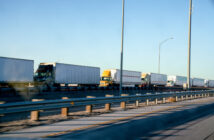Meet the Robot Farmer of Tomorrow
“The engineers were testing the Lettuce Bot, a machine that can “thin” a field of lettuce in the time it takes about 20 workers to do the job by hand. The thinner is part of a new generation of machines that target the last frontier of agricultural mechanization – fruits and vegetables destined for the fresh market, not processing, which have thus far resisted mechanization because they’re sensitive to bruising,” says Time Magazine.
“Researchers are now designing robots for these most delicate crops by integrating advanced sensors, powerful computing, electronics, computer vision, robotic hardware and algorithms, as well as networking and high precision GPS localization technologies. Most ag robots won’t be commercially available for at least a few years.”
In Minnesota, more farmers are using robots to milk cows. “In a small room inside Gary Kieffer’s dairy barn, a cow walks into a metal box. It’s milking time on the farm. Humans are not required,” says Minnesota Public Radio.
“A robotic arm swings below the cow’s udder and two small, spinning brushes set to cleaning. An electronic tag around the cow’s neck pinpoints where she is in her milking cycle. A precise amount of feed — a treat to get the cow in place — falls into a small trough at the end of the box. A laser finds the teats, attaches the milker and starts pumping, recording butterfat and protein levels in the milk.”
Greg Booher at the Font Du Lac Reporter tells readers that cheap labor has inhibited mechanization of agriculture before. “A major reason why American dairymen have been slow to adopt this technology is due to the cost comparison to the cost to manually milk cows. Labor in the U.S. is a lot cheaper than other countries. I recently had an opportunity to talk with a 1,200-cow Australian dairyman about his labor costs,” he says.
“The Australian government has strict wage and labor controls. It mandates dairy farm labor will be paid the U.S. equivalent of $25 per hour. Remember: Their dairy milk price is lower than the average in the United States. Therefore, it is not hard to understand that high-tech labor-saving tools will be more quickly adopted where a quick payback is possible.”
Ryan Says House Will Pass Smaller Bills, Then Merge With Amnesty
“During a town hall meeting in Racine, WI, House Budget Committee Chairman Rep. Paul Ryan (R-WI) revealed the House Republican Leadership plans to pass multiple immigration bills and then combine them with the Senate legislation in the conference process to create a comprehensive bill,” Breitbart News reports.
“Ryan said the goal is to make what he and the House GOP leadership considers improvements to the Senate bill.
‘A lot of people are saying, just pass the Senate bill,’ Ryan explained. ‘That’s not what the House is going to do. I think we can make it better.’ According to the Milwaukee Journal-Sentinel, ‘Ryan said in the House, where the Republicans are in the majority, the intent ‘is to bring five or six bills… to fix these problems one step at a time in a comprehensive way.'”
Rep. Kingston – Time to Close the Tax Credit Loophole for Illegal Aliens
“While the Internal Revenue Service wasted time and taxpayer resources trying to silence conservative groups, it knowingly sent $4.2 billion in taxpayer-funded checks to illegal immigrants each year. You read that right. Despite repeated warnings and reports from its own Inspector General, the IRS did nothing to stop the checks and failed to apply the same standards as required for similar deductions. The Additional Child Tax Credit was created to help working American families offset the costs of raising children,” says a statement from Rep. Jack Kingston (R-GA).
Rep. Goodlatte – 10 Problems With the Senate Amnesty Bill
“The Senate immigration bill is fundamentally flawed and unworkable – that’s why I am opposed to this massive 1,000 page bill. As Chairman of the House Judiciary Committee, I have many concerns about this bill, but here are the top 10 takeaways from the Senate bill,” says Rep. Bob Goodlatte (R-VA). “Unlike the Senate, the House is taking a step-by-step approach to immigration reform, thoroughly and methodically reviewing each component in detail so that we stop mass illegal immigration in the future and ensure our immigration laws are enforced.”
How Amnesty Will Hurt Low-Income Americans
“One of the selling points of immigration reform is that it will boost the economy and raise the U.S.’s GDP. But opponents counter that there will be economic losers in this process, and those hurt by higher immigration may be low-skilled workers who already are having a hard time economically,” says Andrew Biggs at National Review.
“This points to a tricky aspect of thinking about immigration: While the total economic gains are important, it also matters to whom those dollars go, because an income gain to one person doesn’t necessarily offset an equal dollar loss to another. Simply put, it hurts more to lose a dollar if you’re poor than it helps to gain a dollar if you’re rich, an effect of what economists call the ‘declining marginal utility’ of money.”




5 Comments
Awesome, the immigrant engineers in this firm are designing these robots. No wonder we need more high skilled immigrants.
Cheers
There is no doubt that a lot of agricultural work can be done mechanically. It’s already being done by raising crops like tomatoes and lettuces hydroponically in containers, in areas where land is expensive. It takes more money to set up, but in the end is far less labor intensive and involves less use of sprayed chemicals. The yields are also bigger. In the end. It’s more like factory work than the stoop labor previously used. .
DO NOT WORRY LELAND!!!!!!!!! REALLY>>>>>next they will outsource your job TOO!!!…..what a LIFE!!!!
Well, they say this will take 10 years, when is his cousin for Landscaping coming in to reduce the numbers of landscapers or day labors. Also, Juanita the robot maid will reduce the need for maids in hotels or private residents. Another way is some hotels asked for a HSD or GED, many illegal immigrants don’t have this ,unless they came as kids.. Also, maybe some red states could pay a lower minimum wage for minors which might help reduce the number of illegal workers in fast food, but not completely since kids can’t work during school hours or late at night,
Perhaps if We Put the 150K Recently Butcher Axed American Engineers to Work Making Farm Robots to Replace the IA Need?
God Forbid we do that….foreigners must design and build all our American farm robots….the longterm problem is funding without an American manufacturing engineering base….we can’t borrow money forever, sequestration proves that.